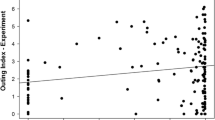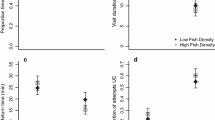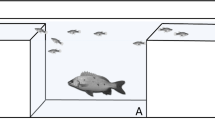Abstract
In the presence of a predator, foraging is a dangerous task. Social individuals can respond to risk by forming groups, benefiting from enhanced collective anti-predator behavior but suffering from increased conspicuousness to predators. Within groups, individuals exhibit variable foraging behavior. One important factor influencing risky foraging behaviour is current energetic state, and individuals must trade off food and safety by deciding when to leave a protected refuge in order to find food. We generated mixed groups of goldfish (Carassius auratus) containing equal numbers of underfed and well-fed individuals and examined individual refuge use and willingness to take risks venturing into risky foraging areas in the presence of an avian predator (little egret—Egretta garzetta). Underfed fish exhibited higher levels of risky behaviour by participating in more foraging outings and emerging from the refuge in frontal group positions, compared with well-fed individuals. As expected, underfed fish benefitted by consuming more food, but surprisingly did not experience higher rates of mortality. This may be due to the fact that the egret predator rarely captured the first fish to emerge from the refuge, preferentially attacked groups of three or more fish, and often captured fish in the chaotic period following a failed initial strike. We demonstrate how differences in energetic condition can influence risk-taking behaviours among social individuals that subsequently influence relative levels of foraging success and group fission–fusion dynamics. Moreover, our results illustrate the risk associated with foraging in larger groups.



Similar content being viewed by others
References
Amano M, IiGo M, Yamamori K (2005) Effects of feeding time on approaching behavior to food odor in goldfish. Fish Sci 71:183–186
Balaban-Feld J, Mitchell WA, Kotler BP, Vijayan S, Elem LTT, Abramsky Z (2018) Influence of predation risk on individual spatial positioning and willingness to leave a safe refuge in a social benthic fish. Behav Ecol Sociobiol 72:87
Bates D, Mächler M, Bolker B, Walker S (2015) Fitting linear mixed-effects models using {lme4}. J Stat Softw 67:1–48
Bateson M (2002) Recent advances in our understanding of risk-sensitive foraging preferences. Proc Nutr Soc 61:509–516
Bednekoff PA (1996) Risk-sensitive foraging, fitness, and life histories: where does reproduction fit into the big picture? Am Zool 36:471–483
Blake CA, Gabor CR (2014) Effect of prey personality depends on predator species. Behav Ecol 25:871–877
Brown JS (1999) Vigilance, patch use and habitat selection: foraging under predation risk. Evol Ecol Res 1:49–71
Brown JS, Kotler BP (2004) Hazardous duty pay and the foraging cost of predation. Ecol Lett 7:999–1014
Brown C, Jones F, Braithwaite V (2005) In situ examination of boldness–shyness traits in the tropical poeciliid, Brachyraphis episcopi. Anim Behav 70:1003–1009
Bumann D, Krause J, Rubenstein D (1997) Mortality risk of spatial positions in animal groups: the danger of being in the front. Behaviour 134:1063–1076
Choi YS, Kwon IK, Yoo JC (2008) A study of feeding methods in five species of herons and egrets in Korea. J Ecol Environ 31:147–151
Clark CW (1994) Antipredator behavior and the asset-protection principle. Behav Ecol 5:159–170
Conradt L, Roper TJ (2000) Activity synchrony and social cohesion: a fission–fusion model. Proc R Soc B 267:2213–2218
DeLong CM, Barbato S, O’Leary T, Wilcox KT (2017) Small and large number discrimination in goldfish (Carassius auratus) with extensive training. Behav Process 141:172–183
Dowling LM, Godin JGJ (2002) Refuge use in a killifish: influence of body size and nutritional state. Can J Zool 80:782–788
Dunlop R, Millsopp S, Laming P (2006) Avoidance learning in goldfish (Carassius auratus) and trout (Oncorhynchus mykiss) and implications for pain perception. Appl Anim Behav Sci 97:255–271
Foster WA, Treherne JE (1981) Evidence for the dilution effect in the selfish herd from fish predation on a marine insect. Nature 293:466
Godin JGJ (1997) Evading predators. Behavioural ecology of teleost fishes. Oxford University Press, Oxford, pp 191–236
Godin JGJ, Crossman SL (1994) Hunger-dependent predator inspection and foraging behaviours in the three spine stickleback (Gasterosteus aculeatus) under predation risk. Behav Ecol Sociobiol 34:359–366
Gotceitas V, Godin JGJ (1991) Foraging under the risk of predation in juvenile Atlantic salmon (Salmo salar L.): effects of social status and hunger. Behav Ecol Sociobiol 29:255–261
Hartwig F (2018) DHARMa: residual diagnostics for hierarchical (multi-level/mixed) regression models. R package version 0.2.0. https://CRAN.R-project.org/package-DHARMa. Accessed 27 Nov 2018
Hirsch BT (2007) Costs and benefits of within-group spatial position: a feeding competition model. Q Rev Biol 82:9–27
Holopainen IJ, Tonn WM, Paszkowski CA (1997) Tales of two fish: the dichotomous biology of crucian carp (Carassius carassius (L.)) in northern Europe. In: Annales Zoologici Fennici. Finnish Zoological and Botanical Publishing Board, Helsinki, pp 1–22
Ingrum J, Nordell SE, Dole J (2010) Effects of habitat complexity and group size on perceived predation risk in goldfish (Carassius auratus). Ethol Ecol Evol 22:119–132
Ioannou CC, Krause J (2008) Searching for prey: the effects of group size and number. Anim Behav 75:1383–1388
Katz MW, Abramsky Z, Kotler BP, Rosenzweig ML, Alteshtein O, Vasserman G (2013) Optimal foraging of little egrets and their prey in a foraging game in a patchy environment. Am Nat 181:381–395
Kotler BP, Brown JS, Bouskila A (2004) Apprehension and time allocation in gerbils: the effects of predatory risk and energetic state. Ecology 85:917–922
Krause J (1993) Positioning behaviour in fish shoals: a cost–benefit analysis. J Fish Biol 43:309–314
Krause J, Godin JGJ (1995) Predator preferences for attacking particular prey group sizes: consequences for predator hunting success and prey predation risk. Anim Behav 50:465–473
Krause J, Ruxton GD (2002) Living in groups. Oxford University Press, Oxford
Krause J, Bumann D, Todt D (1992) Relationship between the position preference and nutritional state of individuals in schools of juvenile roach (Rutilus rutilus). Behav Ecol Sociobiol 30:177–180
Krause J, Reeves P, Hoare D (1998) Positioning behaviour in roach shoals: the role of body length and nutritional state. Behaviour 135:1031–1039
Krause J, Loader SP, Kirkman E, Ruxton GD (1999) Refuge use by fish as a function of body weight changes. Acta Ethol 2:29–34
Kushlan JA (1978) Nonrigorous foraging by robbing egrets. Ecology 59:649–653
Leblond C, Reebs SG (2006) Individual leadership and boldness in shoals of golden shiners (Notemigonus crysoleucas). Behaviour 143:1263–1280
Lima SL (1995) Back to the basics of anti-predatory vigilance: the group-size effect. Anim Behav 49:11–20
Lima SL (1998a) Nonlethal effects in the ecology of predator–prey interactions. Bioscience 48:25–34
Lima SL (1998) Stress and decision making under the risk of predation: recent developments from behavioral, reproductive, and ecological perspectives. In: Advances in the study of behavior. Academic Press, New York, pp 215–290
Lima SL, Dill LM (1990) Behavioral decisions made under the risk of predation: a review and prospectus. Can J Zool 68:619–640
Magurran A (1984) Gregarious goldfish. New Sci 103:32–33
Major PF (1978) Predator–prey interactions in two schooling fishes, Caranx ignobilis and Stolephorus purpureus. Anim Behav 26:760–777
McDonald ND, Rands SA, Hill F, Elder C, Ioannou CC (2016) Consensus and experience trump leadership, suppressing individual personality during social foraging. Sci Adv 2:e1600892
McNamara JM, Houston AI (1992) Risk-sensitive foraging: a review of the theory. Bull Math Biol 54:355–378
Morrell LJ, Romey WL (2008) Optimal individual positions within animal groups. Behav Ecol 19:909–919
Nonacs P (2001) State dependent behavior and the marginal value theorem. Behav Ecol 12:71–83
Olsson O, Brown JS, Smith HG (2002) Long-and short-term state-dependent foraging under predation risk: an indication of habitat quality. Anim Behav 63:981–989
Orrock JL, Preisser EL, Grabowski JH, Trussell GC (2013) The cost of safety: refuges increase the impact of predation risk in aquatic systems. Ecology 94:573–579
Pettersson LB, Brönmark C (1993) Trading off safety against food: state dependent habitat choice and foraging in crucian carp. Oecologia 95:353–357
Pitcher TJ, Magurran AE (1983) Shoal size, patch profitability and information exchange in foraging goldfish. Anim Behav 31:546–555
R Core Team (2016) R: a language and environment for statistical computing. R Foundation for Statistical Computing, Vienna. http://www.R-project.org. Accessed 27 Nov 2018
Romey WL, Galbraith E (2008) Optimal group positioning after a predator attack: the influence of speed, sex, and satiation within mobile whirligig swarms. Behav Ecol 19:338–343
Schuett W, Dall SR (2009) Sex differences, social context and personality in zebra finches, Taeniopygia guttata. Anim Behav 77:1041–1050
Sih A (1992) Prey uncertainty and the balancing of antipredator and feeding needs. Am Nat 139:1052–1069
Sih A (1997) To hide or not to hide? Refuge use in a fluctuating environment. Trends Ecol Evol 12:375–376
Sih A, Kats LB, Maurer EF (2003) Behavioural correlations across situations and the evolution of antipredator behaviour in a sunfish–salamander system. Anim Behav 65:29–44
Silk JB (2007) The adaptive value of sociality in mammalian groups. Proc R Soc B 362:539–559
Stenberg M, Persson A (2005) The effects of spatial food distribution and group size on foraging behaviour in a benthic fish. Behav Process 70:41–50
Teichroeb JA, White MM, Chapman CA (2015) Vervet (Chlorocebus pygerythrus) intragroup spatial positioning: dominants trade-off predation risk for increased food acquisition. Int J Primatol 36:154–176
Therneau TM (2018) coxme: mixed effects Cox models. R package version 2.2-10. https://CRAN.R-project.org/package=coxme. Accessed 27 Nov 2018
Vijayan S, Kotler BP, Elem LTT, Abramsky Z (2018) Effect of predation risk on microhabitat use by goldfish. Ethol Ecol Evol. https://doi.org/10.1080/03949370.2018.1477837
Ward AJ, Hoare DJ, Couzin ID, Broom M, Krause J (2002) The effects of parasitism and body length on positioning within wild fish shoals. J Anim Ecol 71:10–14
Ward AJ, Thomas P, Hart PJ, Krause J (2004) Correlates of boldness in three-spined sticklebacks (Gasterosteus aculeatus). Behav Ecol Sociobiol 55:561–568
Webster MM, Ward AJW, Hart PJB (2007) Boldness is influenced by social context in three spine sticklebacks (Gasterosteus aculeatus). Behaviour 144:351–371
Weir LK, Grant JW (2004) The causes of resource monopolization: interaction between resource dispersion and mode of competition. Ethology 110:63–74
White JR, Meekan MG, McCormick MI, Ferrari MC (2013) A comparison of measures of boldness and their relationships to survival in young fish. PLoS ONE 8:e68900
Acknowledgements
This study was supported by Israel Science Foundation (Grant 05/14 to ZA). SV is grateful to the Azrieli Foundation for the award of a Postdoctoral Fellowship at Ben-Gurion University.
Author information
Authors and Affiliations
Contributions
JBF conceived the experiment and wrote the manuscript; WAM contributed to statistical analyses; BPK, SV, LTTE, and ZA contributed to experimental design, video analyses, and edited early drafts of the manuscript.
Corresponding author
Ethics declarations
Ethical approval
All applicable international, national, and/or institutional guidelines for the care and use of animals were followed. The experiments were conducted in full accordance with the animal care and ethical guidelines of Ben-Gurion University of the Negev, and the Abramsky lab was granted permission to use egrets and goldfish in this study by the committee for the ethical care and use of animals in experiments (authorization number: IL-37-07-2017).
Conflict of interest
The authors declare that they have no conflict of interest.
Additional information
Communicated by Aaron J. Wirsing.
Electronic supplementary material
Below is the link to the electronic supplementary material.
Rights and permissions
About this article
Cite this article
Balaban-Feld, J., Mitchell, W.A., Kotler, B.P. et al. State-dependent foraging among social fish in a risky environment. Oecologia 190, 37–45 (2019). https://doi.org/10.1007/s00442-019-04395-z
Received:
Accepted:
Published:
Issue Date:
DOI: https://doi.org/10.1007/s00442-019-04395-z




